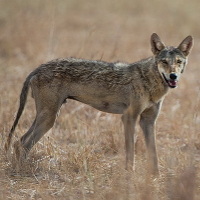 |
Indian wolf |
|
He is a wild animal |
Origin |
India | |
Translation |
Francis Vandersteen |
| The possession of this animal is not authorized Royal Decree establishing the list of mammals not kept for production purposes that may be kept (M.B. 24.08.2009) |
| For a long time, the Indian wolf was thought to be a subspecies of the gray wolf and was recognized as Canis lupus pallipes, the same as the Iranian wolf. However, recent genetic research suggests that the Indian wolf has not interbred with any other subspecies for over 400,000 years, making it a distinct species, Canis indica. Canis lupus pallipes then refers to the wolves of the Arabian Peninsula, Afghanistan and Pakistan, but not India. The Indian wolf is adapted to scrublands, grasslands and semi-arid pastoral environments. It is mainly found in the Indian states of Gujarat, Rajasthan, Haryana, Uttar Pradesh, Madhya Pradesh, Maharashtra, Karnataka and Andhra Pradesh. Its territories range from 260,000 to 450,000 square kilometers. Much of the Indian wolf's habitat overlaps with that of the Himalayan wolf, and because of this, it's a wonder the two don't cross paths. An Indian wolf can be one of the smallest subspecies of wolf, although it varies in height from 61 to 97 cm and weight from 18 to 28 kg, and has a short, dense coat that is generally reddish and tawny in color. The Indian wolf (Canis indica) is relatively smaller and genetically distinct from the Iranian wolf (Canis lupus pallipes). Because of its smaller size, the Indian wolf can sometimes survive on smaller ungulates, rabbits, hares and rodents it finds. However, much of the wildlife that Indian wolves used to hunt has been hunted to extinction by humans. Indian wolves are therefore often forced to hunt livestock. This brings them closer to people, including unsupervised children, whom the wolves regard as fair game. The Indian wolf's breeding season is usually around October, after the rains. Only the alpha males and females of the pack breed. Usually, a brood of 3 to 5 pups is born in December or January in an underground burrow. Mother and father look after the puppies until they are six months old. Although supposedly protected as an endangered species in India under Schedule 1 of the Indian Wildlife Act 1972, the Indian wolf is still hunted for its attacks on children and livestock. The greatest threat to the survival of the Indian wolf is persecution by poison and habitat loss due to intensive agriculture, development and industry. A study published in 2004 estimated that between 2,000 and 3,000 Indian wolves remain in the wild. |






 English (United Kingdom)
English (United Kingdom)